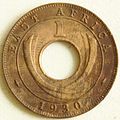The Eastern Caribbean dollar is the currency of all seven full members and one associate member of the Organisation of Eastern Caribbean States (OECS). The successor to the British West Indies dollar, it has existed since 1965, and it is normally abbreviated with the dollar sign $ or, alternatively, EC$ to distinguish it from other dollar-denominated currencies. The EC$ is subdivided into 100 cents. It has been pegged to the United States dollar since 7 July 1976, at the exchange rate of US$1 = EC$2.70.

The shilling is a historical coin, and the name of a unit of modern currencies formerly used in the United Kingdom, Australia, New Zealand, other British Commonwealth countries and Ireland, where they were generally equivalent to 12 pence or one-twentieth of a pound before being phased out during the 1960s and 1970s.

Rupee is the common name for the currencies of India, Mauritius, Nepal, Pakistan, Seychelles, and Sri Lanka, and of former currencies of Afghanistan, Bahrain, Kuwait, Oman, the United Arab Emirates, British East Africa, Burma, German East Africa, and Tibet. In Indonesia and the Maldives, the unit of currency is known as rupiah and rufiyaa respectively, cognates of the word rupee.
The British West Indies dollar (BWI$) was the currency of British Guiana and the Eastern Caribbean territories of the British West Indies from 1949 to 1965, when it was largely replaced by the East Caribbean dollar, and was one of the currencies used in Jamaica from 1954 to 1964. The monetary policy of the currency was overseen by the British Caribbean Currency Board (BCCB). It was the official currency used by the West Indies Federation The British West Indies dollar was never used in British Honduras, the Cayman Islands, the Turks and Caicos Islands, the Bahamas, or Bermuda.

The pound was the currency of Australia from 1910 until 14 February 1966, when it was replaced by the Australian dollar. Like other £sd currencies, it was subdivided into 20 shillings, each of 12 pence.
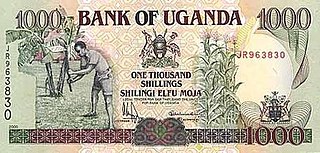
The shilling is the currency of Uganda. Officially divided into cents until 2013, due to substantial inflation the shilling now has no subdivision.

The Somaliland shilling is the official currency of the Republic of Somaliland, an unrecognised sovereign state in the Horn of Africa, recognised internationally as de jure part of Somalia.

The dinar is the currency of Bahrain. It is divided into 1000 fils (فلس). The Bahraini dinar is abbreviated د.ب (Arabic) or BD (Latin). It is usually represented with three decimal places denoting the fils.
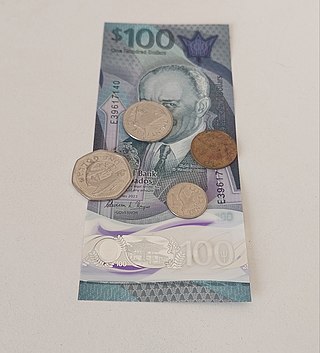
The dollar has been the currency of Barbados since 1935. Globally its currency has the ISO 4217 code BBD, however, unofficially in Barbados the International vehicle registration code BDS is also commonly used, a currency code that is otherwise reserved for Bangladesh outside Barbados. As such the present Barbados dollar has the official ISO 4217 code of BB which matches the [dot] .bb Cc-TLD domain names classification for Barbados under ISO 3166, plus D for dollar in the foreign exchange market. The Barbadian dollar is considered as a currency which can be divided into 100 cents, though the 1 cent coin is in the process of being phased out. In terms of population, Barbados is the third smallest country in the world after Tonga and the Seychelles to have an independent currency and monetary policy.

The Somali shilling is the official currency of Somalia. It is subdivided into 100 senti, cents (English) or centesimi (Italian).
Each "article" in this category is a collection of entries about several stamp issuers, presented in alphabetical order. The entries are formulated on the micro model and so provide summary information about all known issuers.
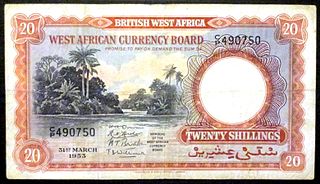
The pound was the currency of British West Africa, a group of British colonies, protectorates and mandate territories. It was equal to one pound sterling and was similarly subdivided into 20 shillings, each of 12 pence.
The Florin was the currency of the British colonies and protectorates of East Africa between 1920 and 1921. It was divided into 100 cents. It replaced the East African rupee at par, and was replaced in turn by the East African shilling at a rate of 2 shillings = 1 florin. The florin was equivalent to 2 shillings sterling.
The rupee was the currency of Britain's East African colonies and protectorates between 1906 and 1920. It was divided into 100 cents.

The pound was the currency of the Union of South Africa from the formation of the country as a British Dominion in 1910. It was replaced by the rand in 1961 when South Africa decimalised.

The Somalo was the currency of the Trust Territory of Somaliland administered by Italy between 1950 and 1960. The "Somalo" remained officially in use in the newly created Somali Republic until 1962. It was subdivided into 100 centesimi.

The lira AOI was a special banknote circulating in Italian East Africa between 1938 and 1941.
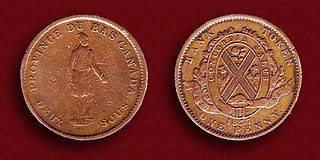
The pound was the currency of the Canadas until 1858. It was subdivided into 20 shillings (s), each of 12 pence (d). In Lower Canada, the sou was used, worth 1⁄2 penny. Although the £sd accounting system had its origins in sterling, the Canadian pound was never at par with sterling's pound.
The history and development of British currency in the Middle East emerged from the 19th century. British involvement in the Middle East began with the Aden Settlement in 1839. The British East India Company established an anti-piracy station in Aden to protect British shipping that was sailing to and from India. The Trucial States were similarly brought into the British Empire as a base for suppressing sea piracy in the Persian Gulf. Involvement in the region expanded to Egypt because of the Suez canal, as well as to Bahrain, Qatar, and Muscat. Kuwait was added in 1899 because of fears about the proposed Berlin-Baghdad Railway. There was a growing fear in the United Kingdom that Germany was a rising power, and there was concern about the implications of access to the Persian Gulf that would arise from the Berlin-Baghdad Railway. After the First World War the British influence in the Middle East reached its fullest extent with the inclusion of Palestine, Transjordan and Iraq.
Prior to European colonization, early Aboriginal Australian communities traded using items such as tools, food, ochres, shells, raw materials and stories, although there is no evidence of the use of currencies.






